NCERT Exemplar Class 7 Maths Chapter 6 Triangles are part of NCERT Exemplar Class 7 Maths. Here we have given NCERT Exemplar Class 7 Maths Solutions Chapter 6 Triangles.
NCERT Exemplar Class 7 Maths Solutions Chapter 6 Triangles
Directions: In each of the questions 1 to 49, four options are given, out of which only one is correct. Choose the correct one.
Question 1.
The sides of a triangle have lengths (in cm) 10,6.5 and a, where a is a whole number. The minimum value that a can take is
(a) 6
(b) 5
(c) 3
(d) 4
Solution:
(d) Lengths of sides of the triangle are 10 cm, 6.5 cm and a cm.
Since, sum of lengths of any two sides of a triangle is greater than length of third side.
∴ 10 + 6.5 > a, 10+ > 6.5, 6.5 + a > 10
⇒ 16.5 > a, a > -3.5, a > 3.5
Given that a is a whole number
∴ Minimum value that a can take is 4.
Question 2.
Triangle DEF of the given figure is a right triangle with ∠E = 90°.
What type of angles are ∠D and ∠F?
(a) They are equal angles
(b) They form a pair of adjacent angles
(c) They are complementary angles
(d) They are supplementary angles
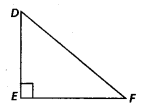
Solution:
(c) ∠D + ∠E + ∠F = 180° [Angle sum property of a triangle]
∠D + ∠F = 180°- 90° [∵∠E = 90° (given)]
= 90°
∴ ∠D and ∠F are complementary angles.
Question 3.
In the given figure, PQ = PS. The value of x is
(a) 35°
(b) 45°
(c) 55°
(d) 70°
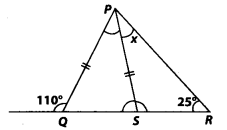
Solution:
(b) In APQS, ∠2 + ∠3 = 110° ……….(i) [Exterior angle property of a triangle]
∠2 + ∠3 + ∠4 = 180° [Angle sum property of a triangle]

⇒ ∠4 = 180° = 110° [Using (i)]
∴ ∠4 = 70°
Now, PQ = PS (given)
⇒ ∠2 = ∠4 = 70° ……………. (ii)
(ii) Now, in ∆PRS,
∠2 = x + 25° [Exterior angle property of a triangle]
⇒ x = 70° – 25° = 45° [Using (ii)]
Question 4.
In a right-angled triangle, the angles other than the right angle are
(a) obtuse
(b) right
(c) acute
(d) straight
Solution:
(c) The sum of angles other than right angle in a right-angled triangle is 90°
∴ Both angles other than the right angle must be acute.
Question 5.
In an isosceles triangle, one angle is 70°. The other two angles are of
(i) 55° and 55°
(ii) 70° and 40°
(iii) any measure
In the given option(s) which of the above statement(s) are true?
(a) (i) only
(b) (ii) only
(c) (iii) only
(d) (i) and (ii)
Solution:
(d) Case I: Let ∆ABC be the given isosceles triangle in which AB = AC and vertex angle is 70°.
∠1 = ∠2 ………. (i) [∵ AB = AC]
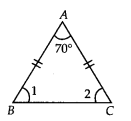
Now, ∠1 + ∠2 + ∠A = 180° [Angle sum property]
⇒ 2(∠1) = 180° – 70° [Using (i)]
\(\Rightarrow \angle 1=\frac{110^{\circ}}{2}=55^{\circ}\)
Thus, ∠1 = ∠2 = 55°
Hence, (i) is true.
Case II:
Let ∆ABC be the given isosceles triangle in which AB = AC and base angle is 70°.
∠2 = 70° [∵ AB = AC]
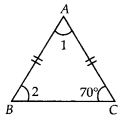
Now, ∠1 + ∠2 + ∠C = 180°
⇒ ∠1 = 180° – 70° – 70°
⇒ ∠1 = 40°
Thus, ∠1= 40° and ∠2 = 70°
Hence, (ii) is also true.
Question 6.
In a triangle, one angle is of 90°. Then
(1) The other two angles are of 45° each
(ii) In the remaining two angles, one angle is 90° and the other is 45°
(iii) Remaining two angles are complementary
In the given option(s) which is true?
(a) (i) only
(b) (ii) only
(c) (iii) only
(d) (i) and (ii)
Solution:
(c) In a triangle, if one angle is of 90°, the remaining two angles are complementary.
Question 7.
Lengths of sides of a triangle are 3 cm, 4 cm and 5 cm. The triangle is
(a) Obtuse-angled triangle
(b) Acute-angled triangle
(c) Right-angled triangle
(d) An isosceles right triangle
Solution:
(c) Lengths of sides of a triangle are 3 cm, 4 cm and 5 cm.
Now, 32 + 42 = 9 + 16 = 25 = 52
i.e., sum of squares of two sides is equal to square of third side. Therefore, triangle is right angled triangle.
Question 8.
In the given figure, PB = PD. The value of x is
(a) 85°
(b) 90°
(c) 25°
(d) 35°
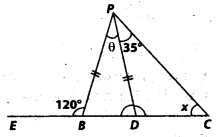
Solution:
(c) ∠PBE = ∠PDB + ∠BPD [Exterior angle property]
⇒ 120° = ∠PDB + θ ………….. (i)
Now, in ΔPBD, ∠PBD + ∠BPD + ∠PDB = 180° [Angle sum property]
⇒ ∠PBD + θ + ∠PDB = 180°
⇒ ∠PBD = 180° – 120° = 60° [Using (i)]
And PB = PD (given)
∵ ∠PDB = ∠PBD = 60° ………. (ii)
Now, in ΔPDC,
∠PDB = ∠DCP + ∠DPC [Exterior angle property]
⇒ 60° = x + 35° [Using (ii)]
[∵ ∠DCP = x, ∠DPC = 35° (given)]
⇒ x = 60° – 35° = 25°
Question 9.
In ΔPOR,
(a) PQ – QR > PR
(b) PQ + QR < PR
(c) PQ – QR < PR
(d) PQ + PR < OR
Solution:
(c) In a ΔPOR, PQ +OR >PR: QR + PR > PO; PR + PQ > QR
[∵ Sum of any two sides of a triangle is greater than the third side]
And PQ – QR < PR; QR – PR < PQ
PR – PQ < QR [∵ Difference of any two sides of a triangle is less than the third side].
Question 10.
In ΔABC,
(a) AB + BC > AC
(b) AB +BC < AC
(c) AB + AC < BC
(d) AC + BC < AB
Solution:
(a) In a ΔABC, AB + BC > AC: BC + AC > AB; AC + AB > BC
[∵ Sum of two sides is greater than third side in a triangle]
Question 11.
The top of a broken tree touches the ground at a distance of 12 m from its base. If the tree is broken at a height of 5 m from the ground then the actual height of the tree is (a) 25 m
(b) 13 m
(c) 18 m
(d) 17 m
Solution:
(c) Let BC is the broken part of tree and AB is the unbroken part of tree.
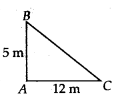
Here, ΔABC is right angled triangle
(BC)2 = (AB)2 + (AC)2
⇒(BC)2 = (5)2 + (12)2
⇒ (BC)2 = 25 + 144 = 169
⇒ (BC)2 = 132
⇒ BC = 13 m
∴ Actual height of tree is AB + BC = (5 + 13) m = 18 m
Question 12.
The triangle ABC formed by AB = 5 cm, BC = 8 cm, AC = 4 cm is
(a) an isosceles triangle only
(b) a scalene triangle only
(c) an isosceles right triangle
(d) scalene as well as a right triangle
Solution:
(b) AB = 5 cm, BC = 8 cm, AC = 4 cm
Now 52 + 42 = 25 + 16 = 41 ≠ 82
And all sides are unequal.
∴ ΔABC is a scalene triangle only.
Question 13.
Two trees 7 m and 4 m high stand upright on a ground. If their bases (roots) are 4 m apart, then the distance between their tops is
(a) 3 m
(b) 5 m
(c) 4 m
(d) 11 m
Solution:
(b) Let AB and CD are the given trees of height 7 m and 4 m respectively.
AC = DE = 4 m
BE = AB – AE = (7 – 4) m = 3 m ( ∵ AE = CD = 4 m)
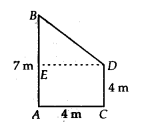
Now, ΔBED is a right angled triangle
∴ (BD)2 = (BE)2 + (DE)2
⇒ (BD)2 = (3)2 + (4)2 = 9 + 16
⇒ (BD)2 = 25 – 52
⇒ BD = 5 m
Hence, the distance between the tops of trees is 5 m.
Question 14.
If in an isosceles triangle, each of the base angles is 40°, then the triangle is
(a) Right – angled triangle
(b) Acute angled triangle
(c) Obtuse-angled triangle
(d) Isosceles right-angled triangle
Solution:
(c) Let ΔABC be the given isosceles triangle in which AB = AC and each base angle is 40°.
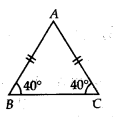
Now, ∠A +∠B + ∠C = 180° (Angle sum property)
⇒ ∠A = 180° – 40° – 40° = 100° ( Each base angle is 40°)
Thus, ΔABC is an obtuse angled triangle.
Question 15.
If two angles of a triangle are 60° each, then the triangle is
(a) Isosceles but not equilateral
(b) Scalene
(c) Equilateral
(d) Right – angled.
Solution:
(c) Let ΔABC be the given triangle in which two angles are of 60° each.
Now, ∠A +∠B + ∠C = 180° (Angle sum property)
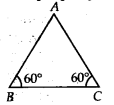
⇒ ∠A = 180° – 60° – 60°
∴ ∠A = 60°
Thus, all angles are of 60°
Hence, ΔABC is an 60° equilateral triangle
Question 16.
The perimeter of the rectangle whose length is 60 cm and a diagonal is 61 cm is
(a) 120 cm
(b) 122 cm
(c) 71 cm
(d) 142 cm
Solution:
(d) Let ΔBCD be the given rectangle such that AB =CD = 60 cm and AC = 61 cm.

In ΔABC,
(AC)2 = (AB)2 + (BC)2
⇒ (61)2 = (60)2 + (BC)2
⇒ (BC)2 = 3721 – 3600 = 121 = 112
⇒ BC = 11 cm
∴ Perimeter of rectangle ABCD = 2(AB + BC)
= 2 (60 + 11) = 2(71) = 142 cm
Question 17.
In ΔPOR, If PQ = OR and ∠Q=100°, then ∠R is equal to
(a) 40°
(b) 80°
(c) 120°
(d) 50°
Solution:
(a) Let ∠R = x
PQ = QR (given)
∴ ∠R =∠P = x
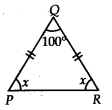
Now, in ΔPOR
∠P + ∠Q + ∠R = 180° (Angle sum property)
⇒ x + 100° + x = 180°
⇒ 2x = 180° – 100° = 80°
\(\Rightarrow \quad x=\frac{80^{\circ}}{2}=40^{\circ}\)
Thus, ∠R = 40°
Question 18.
Which of the following statements is not correct?
(a) The sum of any two sides of a triangle is greater than the third side
(b) A triangle can have all its angles acute
(c) A right-angled triangle cannot be equilateral
(d) Difference between any two sides of a triangle is greater than the third side
Solution:
(d) Since the difference of any two sides of a triangle is less than the third side.
Question 19.
In the given figure, BC = CA and ∠A = 40°. Then, ∠ACD is equal to the
(a) 40°
(b) 80°
(c) 120°
(d) 60°
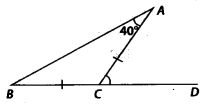
Solution:
(b) BC = CA [given]
⇒ ∠A = ∠B = 40° [∵ Angles opposite to equal sides are equal]
Now, ∠ACD = ∠A + ∠B [Exterior angle property]
= 40° + 40° = 80°
Question 20.
The length of two sides of a triangle are 7 cm and 9 cm. The length of the third side may lie between
(a) 1 cm and 10 cm
(b) 2 cm and 8 cm
(c) 2 cm and 16 cm
(d) 1 cm and 16 cm
Solution:
(c) Length of two sides of a triangle are 7 cm and 9 cm.
Let the length of third side be x cm.
Since, sum of two sides is greater than third side in a triangle.
∴ 7 + 9 > x, 7 + x > 9, 9 + x > 7
⇒ 16 > x, x > 2, x > -2
Since, side length cannot be negative.
∴ 2 < x < 16
Thus, the third side may lie between 2 cm and 16 cm
Question 21.
From the given figure, the value of x is
(a) 75°
(b) 90°
(c) 120°
(d) 60°
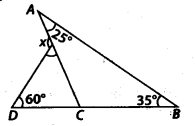
Solution:
(c) In ∆ABC, ∠ACD =∠CAB + ∠ABC [Exterior angle property]
⇒ ∠ACD – 25° + 35°
⇒ ∠ACD = 60° ……….. (i)
Now, x = ∠D +∠ACD, [Exterior angle property]
⇒ x = 60° + 60° [Using (i)] .
∴ x = 120°
Question 22.
In the given figure, the value of ∠A +∠B +∠C + ∠D + ∠E +∠F is
(a) 190°
(b) 540°
(c) 360°
(d) 180°
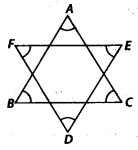
Solution:
(c) In ∆ABC,
∠A + ∠B + ∠C = 180° ………… (i) (Angle sum property)
In ∆DEF,
∠D+ ∠E + ∠F = 180° ………..(ii) (Angle sum property)
Adding (i) and (ii),
∠A+∠B+ ∠C + ∠D+ ∠E+∠F
= 180° + 180° = 360°
Question 23.
In the given figure, PQPR, RS = RQ, and ST || QR. If the exterior angle RPU is 140°, then the measure of angle TSR is (a) 55°
(b) 40°
(c) 50°
(d) 45°

Solution:
(b) In ∆PQR,
∠RPU – ∠PRQ+ ∠PQR [Exterior angle property]
⇒ 140° = 2 ∠POR [∵ PQ = PR ∴ ∠PRQ = ∠PQR]
\(\rightarrow \angle P Q R=\frac{140^{\circ}}{2}=70^{\circ}\)
ST || QR and QS is a transversal.
∴ ∠PST = ∠PQR = 70° ………..(ii) [Corresponding angles]
Now, in ∆QSR RS = RQ (given) .
∴ ∠SQR – ∠RSQ = 70°
Now, PQ is a straight line.
∴ ∠PST + ∠TSR + ∠RSQ = 180°
⇒ 70° + ∠TSR + 70° = 180° [Using (ii) and (iii)]
⇒ ∠TSR = 180° – 70° – 70 = 40°
Question 24.
In the given figure, ∠BAC = 90°, AD ⊥ BC and ∠BAD = 50°, then ∠ACD is
(a) 50°
(b) 40°
(c) 70°
(d) 60°
Solution:
(a) Given that
∠BAC = 90° and ∠BAD = 50°
∴ ∠DAC = ∠BAC – ∠BAD = 90° – 50° = 40°
Now, in ∆ADC,
∠ADB = ∠DAC + ∠ACD [Exterior angle property]
⇒ 90° = 40° + ∠ACD [∵ AD ⊥ BC]
⇒ ∠ACD = 90° – 40° = 50°
Question 25.
If one angle of a triangle is equal to the sum of the other two angles, the triangle is
(a) obtuse
(b) acute
(c) right
(d) equilateral
Solution:
(c) Let angles of a triangle be x, y, z
such that x = y + z ………. (i)
Now, x + y + z = 180° [Angle sum property]
⇒ x + x = 180° [Using (1)]
⇒ 2x = 180°
\(\Rightarrow x=\frac{180^{\circ}}{2}=90^{\circ}\)
Thus, triangle is right angled.
Question 26.
If the exterior angle of a triangle is 130° and its interior opposite angles are equal, then measure of each interior opposite angle is
(a) 55°
(b) 65°
(c) 50°
(d) 60°
Solution:
(b) Let interior opposite angles are x and x.
∴ 130° = x + x [Exterior angle property]
⇒ 2x = 130°
\(\Rightarrow \quad x=\frac{130^{\circ}}{2}=65^{\circ}\)
Thus, each interior opposite angle is of 65°
Question 27.
If one of the angles of a triangle is 110°, then the angle between the bisectors of the other two angles is
(a) 70°
(b) 110°
(c) 35°
(d) 145°
Solution:
(d) Let ∆ABC be the given triangle such that ∠A = 110° and OB, OC are the angle bisectors of ∠B, C respectively.
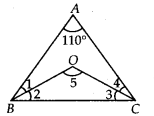
∴∠1 =∠2, ∠3 = 4 ………. (i)
In ΔΑΒC,
∠A + ∠B + ∠C = 180° [Angle sum property]
⇒ 110° +∠1 + ∠2 + ∠3 + ∠4 = 180°
⇒ 2(∠2) +2(∠3) = 180° – 110° [Using (1)]
⇒ 2(∠2 + ∠3) = 70°
\(\Rightarrow \quad \angle 2+\angle 3=\frac{70^{\circ}}{2}=35^{\circ}\) …………(ii)
Now, in ∆OBC
∠BOC + ∠OBC +∠OCB = 180° [Angle sum property]
⇒ ∠BOC + ∠2 + ∠3 = 180°
⇒ ∠BOC = 180° – 35° = 145° [Using (ii)]
Thus, required angle is 145° .
Question 28.
In ∆ABC, AD is the bisector of ∠A meeting BC at D, CF ⊥ AB and E is the mid-point of AC. Then median of the triangle is
(a) AD
(b) BE
(c) FC
(d) DE
Solution:
(b) Since, median of a triangle divides the opposite side into two equal parts. Therefore, BE is the median.
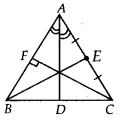
Question 29.
In ∆PQR, if ∠P = 60°, and ∠Q = 40°, then the exterior angle formed by producing QR is equal to
(a) 60°
(b) 120
(c) 100°
(d) 80°
Solution:
(c) Let QR is produced to a point S.
In ∆POR, ∠PRS = ∠P + ∠Q [Exterior angle property]
∠PRS = 60° + 40 = 100°

Question 30.
Which of the following triplets cannot be the angles of a triangle?
(a) 67°, 51°, 62°
(b) 70°, 83°, 27°
(c) 90°, 70°, 20°
(d) 40°, 132°, 18°
Solution:
(d) Since, sum of angles of a triangle is 180° but 40° + 132° + 18° = 190°
∴ 40°, 132°, 18° are not the angles of a triangle
Question 31.
Which of the following can be the length of the third side of a triangle whose two sides measure 18 cm and 14 cm?
(a) 4 cm
(b) 3 cm
(c) 5 cm
(d) 32 cm
Solution:
(c) Let third side of the triangle be x cm.
Since, sum of any two sides of a triangle is greater than the third side.
∴ 18 + x > 14, 14 + x > 18, 18 + 14 > x
⇒ x > -4, x > 4, 32 > x
Since, length can not be negative.
Thus, 4 < x < 32
Hence, third side of triangle can be 5 cm.
Question 32.
How many altitudes does a triangle have?
(a) 1
(b) 3
(c) 6
(d) 9
Solution:
(b) A triangle has 3 altitudes.
Question 33.
If we join a vertex to a point on the opposite side which divides that side in the ratio 1:1, then what is the special name of that line segment?
(a) Median
(b) Angle bisector
(c) Altitude
(d) Hypotenuse
Solution:
(a) Median is a line segment which divides the opposite side in the ratio 1 : 1.
Question 34.
The measures of x and y in the given figure are respectively
(a) 30°, 60°
(b) 40°, 40°
(c) 70°, 70°
(d) 70°, 60°

Solution:
(d) In ∆PQR, ∠PRS = ∠RPQ + ∠POR (Exterior angle property)

⇒ 120° = x + 50°
⇒ x = 120°- 50° = 70°
Now, x + y + 50° = 180° (Angle sum property)
⇒ 70° + y + 50° = 180°
⇒ y = 180° – 70°- 50° = 60°
Thus, x = 70°, y = 60°
Question 35.
If length of two sides of a triangle are 6 cm and 10 cm, then the length of the third side can be
(a) 3 cm
(b) 4 cm
(c) 2 cm
(d) 6 cm
Solution:
(d) Let third side of the triangle be x cm.
Since, sum of any two side of a triangle is greater than third side.
∴ 6 + x > 10; 10 + x > 6; 10 + 6 > x
⇒ x > 4; x > -4; x < 16
Since, the length can not be negative.
Thus, 4 < x < 16
Hence, third side can be 6 cm.
Question 36.
In a right-angled triangle ABC, if angle B = 90°, BC = 3 cm and AC = 5 cm, then the length of side AB is
(a) 3 cm
(b) 4 cm
(c) 5 cm
(d) 6 cm
Solution:
(b) In the right angled triangle ∆ABC,

(AC)2 = (AB)2 + (BC)2
⇒ 52 = (AB)2 + 32
⇒ (AB)2 = 25 – 9 = 16 = 42
⇒ AB = 4 cm
Question 37.
In a right-angled triangle ABC, if angle B = 90°, then which of the following is true?
(a) AB2 = BC2 + AC2
(b) AC2 = AB2 + BC2
(c) AB =BC + AC
(d) AC = AB + BC
Solution:
(b) In the right angled triangle AABC, given that

∠B = 90°
∴ (AC)2 = (AB)2 + (BC)2
Question 38.
Which of the following figures will have its altitude outside the triangle?
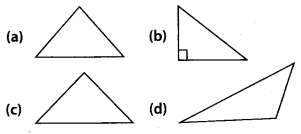
Solution:
(d)

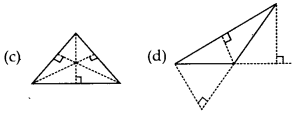
Thus, triangle in option (d) has its altitude outside the triangle.
Question 39.
In the given figure, if AB|| CD, then
(a) ∠2 = ∠3
(b) ∠1 = ∠4
(c) ∠4 = ∠1 + ∠2
(d) ∠1 + ∠2 = ∠3 + ∠4
Solution:
(d) Given, AB || CD
∴ ∠2 = ∠4 …….. (i) (Corresponding angles)
And ∠1 = ∠3 ………..(ii) [Alternate interior angles]
Adding (i) and (ii), we get
∠1 + ∠2 = ∠3 + ∠4
Question 40.
In ∆ABC, ∠A = 100%, AD bisects ∠A and AD ⊥ BC. Then, ∠B is equal to
(a) 80°
(b) 20°
(c) 40°
(d) 30°
Solution:
(c) AD bisects, ∠A.
∴ \(\quad \angle B A D=\angle D A C=\frac{1}{2} \angle B A C\)
\(\Rightarrow \quad \angle B A D=\frac{100^{\circ}}{2}=50^{\circ}\)
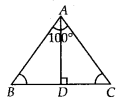
Now, AD ⊥ BC
∴ ∠ADC = 90°
Now, in ∆ABD,
∠ADC = ∠ABD + ∠BAD [Exterior angle property]
⇒ 90° = ∠ABD + 50°
⇒ ∠ABD = 90°- 50° = 40°
Thus, ∠B = 40°
Question 41.
In AABC, ∠A = 50°, ∠B = 70° and bisector of ∠C meets AB in D (see figure). Measure of ∠ADC is
(a) 50°
(b) 100°
(c) 30°
(d) 70°
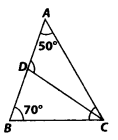
Solution:
(b) In ∆ABC, ∠A +∠B + ∠C = 180° [Angle sum property]
⇒ ∠C = 180° – 70° – 50°
⇒ ∠C = 60 °
Since, CD bisects ∠C.
∴ \(\quad \angle D C B=\angle A C D=\frac{1}{2} \angle C=\frac{60^{\circ}}{2}=30^{\circ}\)
Now, in ∆BDC, ∠ADC = ∠DBC + ∠DCB [Exterior angle property]
⇒ ∠ADC = 70° + 30 = 100°
Question 42.
If for ∆ABC and ∆DEF, the correspondence CAB ⟷ EDF gives a congruence, then which of the following is not true?
(a) AC = DE
(b) AB = EF
(c) ∠A = ∠D
(d) ∠C= ∠E
Solution:
(b) Given that ∆CAB ≅ ∆EDF
∴ AC = DE, AB = DF, BC = FE, ∠A =∠D, ∠C = ∠E, ∠B = ∠F
Question 43.
In the given figure, M is the mid-point of both AC and BD. Then
(a) ∠1 = ∠2
(b) ∠1 = ∠4
(c) ∠2 = ∠4
(d) ∠1 = ∠3
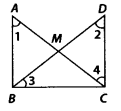
Solution:
(b) In ∆AMB and ∆CMD,
AM = CM [M is mid-point of AC]
BM = DM [M is mid-point of BD]
∠AMB = ∠CMD [Vertically opposite angles]
∴ ∠AMB ≅ ∠CMD [SAS criterion]
∴ ∠1 = ∠4 [By C.P.C.T]
Question 44.
If D is the mid-point of the side BC in ∆ABC where AB = AC, then ∠ADC is
(a) 60°
(b) 45°
(c) 120°
(d) 90°
Solution:
(d) In ∆ABD and ∆ACD,
AD = AD [common]
AB = AC [given]
BD = CD [D is mid-point of BC]
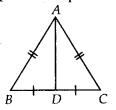
∴ ∆ABD = ∆ACD [SSS criterion]
∴ ∠ADB = ∆ADC [By C.P.C.T]
But ∠ADB + ∠ADC = 180° [∵ BC is a straight line]
⇒ ∠ADC + ∠ADC = 180°
⇒ 2 ∠ADC = 180°
⇒ ∠ADC = 90°
Question 45.
Two triangles are congruent, if two angles and the side included between them in one of the triangles are equal to the two angles and the side included between them of the other triangle. This is known as the
(a) RHS congruence criterion
(b) ASA congruence criterion
(c) SAS congruence criterion
(d) AAA congruence criterion
Solution:
(b)
Question 46.
By which congruency criterion, the two triangles in the given figure are congruent?
(a) RHS
(b) ASA
(c) SSS
(d) SAS
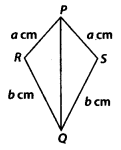
Solution:
(c) In ∆PRQ and ∆PSQ,
PQ =PQ [common]
PR = PS = a cm [given]
QR = QS = b = cm [given]
∴ ∆PRQ = ∆PSQ [SSS criterion]
Question 47.
By which of the following criterion two triangles cannot be proved congruent?
(a) AAA
(b) SSS
(c) SAS
(d) ASA
Solution:
(a) By AAA criterion two triangles cannot be proved congruent.
Question 48.
If ∆POR is congruent to ∆STU (see figure), then what is the length of TU?
(a) 5 cm
(b) 6 cm
(c) 7 cm
(d) cannot be determined

Solution:
(b) Given that
∆POR ≅ ∆STU
∴ TU = OR = 6 cm
Question 49.
If ∆ABC and ∆DBC are on the same base BC, AB = DC and AC = DB (see figure), then which of the following gives a congruence relationship?
(a) ∆ABC ≅ ∆DBC
(b) ∆ABC ≅ ∆CBD
(c) ∆ABC ≅ ∆DCB
(d) ∆ABC ≅ ∆BCD

Solution:
(c) In ∆ABC and ∆DCB,
AB = DC (given)
AC = DB (given)
BC = CB (common)
∴ ∆ABC ≅ ∆DCB (SSS criterion)
Directions: In questions 50 to 69, fill in the blanks to make the statements true.
Question 50.
The ________ triangle always has altitude outside itself.
Solution:
Obtuse-angled
Question 51.
The sum of an exterior angle of a triangle and its adjacent angle is always ________
Solution:
180°
Question 52.
The longest side of a right-angled triangle is called its ________
Solution:
Hypotenuse
Question 53.
Median is also called ________ in an equilateral triangle.
Solution:
Altitude
Question 54.
Measures of each of the angles of an equilateral triangle is ________
Solution:
60°
Question 55.
In an isosceles triangle, two angles are always ________
Solution:
Equal
Question 56.
In an isosceles triangle, angles opposite to equal sides are ________
Solution:
Equal
Question 57.
If one angle of a triangle is equal to the sum of other two, then the measure of that angle is ________
Solution:
90°: Let angles of triangle be x, y and z.
Given that x = y +z ………… (i)
Now, x + y + z-180° [Angle sum property]
⇒ x + x = 180° [Using (i)]
⇒ 2x = 180°
⇒ x = 90°
Question 58.
Every triangle has at least ________ acute angle(s).
Solution:
Two
Question 59.
Two line segments are congruent, if they are ________ lengths.
Solution:
Equal
Question 60.
Two angles are said to be ________ if they have equal measures.
Solution:
Congruent
Question 61.
Two rectangles are congruent, if they have same ________ and ________
Solution:
Length, breadth
Question 62.
Two squares are congruent, if they have same ________
Solution:
Side
Question 63.
If ∆POR and ∆XYZ are congruent under the correspondence QPR ⟷ XYZ, then
(i) ∠R = ________
(ii) QR = ________
(iii) ∠P = ________
(iv) OP = ________
(v) ∠Q = ________
(vi) RP = ________
Solution:
Given that ∆QPR = ∆XYZ
(i) ∠R = Z
(ii) QR = XZ
(iii) ∠P = ∠Y
(iv) OP = XY
(v) ∠Q = ∠X
(vi) RP =ZY
Question 64.
In the given figure, ∆PQR ≅ A ________

Solution:
XZY: In ∆PQR and ∆XZY,
PQ = XZ = 3.5 cm
∠PQR = ∠XZY = 45°
QR = ZY = 5 cm
∴ ∆PQR ≅ ∆XZY [SAS criterion]
Question 65.
In the given figure, ∆PQR ≅ ∆ ________
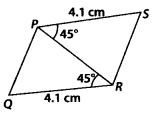
Solution:
RSP : In ∆PQR and ∆RSP,
QR = SP = 4.1 cm
∠PRQ = ∠RPS = 45°
PR = RP [common]
∴ ∆PQR ≅ ∆RSP [SAS criterion]
Question 66.
In the given figure, ∆ ________ ≅ ∆PQR

Solution:
DRQ: In ∆PQR and ∆DRQ,
∠PRQ = ∠DQR = 40°
∠PQR = ∠DRQ = 30° + 40° = 70°
QR = RQ [common]
∴ ∆PQR ≅ ∆DRO [ASA criterion]
Question 67.
In the given figure, ∆ARO ≅ ∆ __________
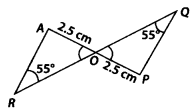
Solution:
PQO: In ∆ARO and ∆PQO,
∠ARO = ∠PQO = 55°
∠AOR = ∠POQ [Vertically opposite angles]
∴ ∠RAQ = ∠QPO
[∵ If two angles of a triangle are equal to two angles of another triangle then third angle is also equal]
AO = PO = 2.5 cm
∴ ∆ARO ≅ ∆PQO [ASA criterion]
Question 68.
In the given figure, AB = AD and ∠BAC = ∠DAC. Then
(i) ∆ ________ ≅ AABC.
(ii) BC = ________
(iii) ∠BCA = ________
(iv) Line segment AC bisects ________ and ________
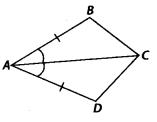
Solution:
In ∆ABC and ∆ADC,
AC = AC [common]
∠BAC = ∠DAC [given]
AB = AD [given]
∴ ∆ABC ≅ ∆ADC [SAS criterion]
∴ BC = DC [By C.P.C.T.]
and ∠BCA = ∠DCA [By C.P.C.T.]
(i) ∆ADC ≅ ∆ABC
(ii) BC = DC
(iii) ∠BCA = ∠DCA
(iv) Line segment AC bisects ∠BAD and ∠BCD.
Question 69.
In the given figure,
(i) ∠TPQ = ∠ ______ + ∠ _______
(ii) ∠UQR = ∠______ + ∠ ______
(iii) ∠PRS = ∠ ______ + ∠ _______
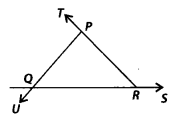
Solution:
(i) PQR, PRQ: ∠TPQ = ∠PQR + ∠PRQ [Exterior angle property]
(ii) QPR, QRP: ∠UQR = ∠QPR + ∠QRP [Exterior angle property]
(iii) RPQ, ROP: ∠PRS = ∠RPQ + ∠ROP [Exterior angle property]
Directions: In questions 70 to 106 state whether the statements are True or False.
Question 70.
In a triangle, sum of squares of two sides is equal to the square of the third side.
Solution:
False
Since, in a right-angled triangle, sum of squares of two sides is equal to the square of the third side.
Question 71.
Sum of two sides of a triangle is greater than or equal to the third side.
Solution:
False
Since, sum of two sides of a triangle is greater than the third side.
Question 72.
The difference between the lengths of any two sides of a triangle is smaller than the length of third side.
Solution:
True
Question 73.
In ∆ABC, AB = 3.5 cm, AC = 5 cm, BC = 6 cm and in ∆POR, PR = 3.5 cm, PQ = 5 cm, RQ=6 cm. Then ∆ABC ⟷ ∆PQR.
Solution:
False
In ∆ABC and ∆POR,
AB = PR = 3.5 cm
AC = PQ = 5 cm
BC = RO = 6 cm
∴ ∆ABC ⟷ ∆PRQ (SSS congruency)
Question 74.
Sum of any two angles of a triangle is always greater than the third angle.
Solution:
False
Since, sum of any two angles of a triangle is may or may not be greater than the third angle.
Question 75.
The sum of the measures of three angles of a triangle is greater than 180°
Solution:
False
Since, the sum of the measures of three angles of a triangle is equal to 180°
Question 76.
It is possible to have a right-angled equilateral triangle.
Solution:
False
Since, an equilateral triangle cannot be a right-angled triangle.
Question 77.
If M is the mid-point of a line segment AB, then we can say that AM and MB are congruent.
Solution:
True
Since, M is mid-point of AB.
![]()
∴ AM = MB
⇒ AM = MB
Question 78.
It is possible to have a triangle in which two of the angles are right angles.
Solution:
False
Let two angle of a triangle be 90° and third angle be x. Then
90° + 90° + x = 180° (Angle sum property)
⇒ x = 180° – 180° = 0°
which is not possible.
Question 79.
It is possible to have a triangle in which two of the angles are obtuse.
Solution:
False
Let two angles x and y of a triangle are obtuse.
Then x > 90° ………..(i)
and y > 90° …………. (ii)
From (i) and (ii), we have x + y > 180°
But in a triangle sum of all angles can not be greater than 180° .
∴ Triangle is not possible.
Question 80.
It is possible to have a triangle in which two angles are acute.
Solution:
True
Question 81.
It is possible to have a triangle in which each angle is less than 60°
Solution:
False
If all angles of a triangle are less than 60°, then their sum will be less than 180°. But in a triangle sum of all angles is 180°.
∴ Triangle is not possible.
Question 82.
It is possible to have a triangle in which each angle is greater than 60°
Solution:
False
If all angles of a triangle are greater than 60°, then their sum will be greater than 180°. But in a triangle sum of all angles is 180°
∴ Triangle is not possible.
Question 83.
It is possible to have a triangle in which each angle is equal to 60°
Solution:
True
Since in equilateral triangle each angle is equal to 60°.
Question 84.
A right-angled triangle may have all sides equal.
Solution:
False
A right-angled triangle may have two sides equal.
Question 85.
If two angles of a triangle are equal, the third angle is also equal to each of the other two angles.
Solution:
False
If two angles of a triangle are equal then third angle may or may not be equal to each of the other two angles.
Question 86.
In the given figure, two triangles are congruent by RHS.

Solution:
False
Since, given triangles are congruent by SAS.
Question 87.
The congruent figures superimpose each other completely.
Solution:
True
Question 88.
A one rupee coin is congruent to a five rupee coin.
Solution:
False
Since, one rupee coin and five rupee coin are of different size so they are not congruent.
Question 89.
The top and bottom faces of a kaleidoscope are congruent.
Solution:
True
Question 90.
Two acute angles are congruent.
Solution:
False
Since, two acute angles may vary from 0° to 89°. So, two acute angles of different measure are not congruent.
Question 91.
Two right angles are congruent.
Solution:
True
Question 92.
Two figures are congruent, if they have the same shape.
Solution:
False
Since, two figures are congruent, if they have the same shape and same size.
Question 93.
If the areas of two squares is same, they are congruent.
Solution:
True
Question 94.
If the areas of two rectangles are the same, they are congruent.
Solution:
False
Question 95.
If the areas of two circles are the same, they are congruent.
Solution:
True
Question 96.
Two squares having the same perimeter are congruent.
Solution:
True
Question 97.
Two circles having the same circumference are congruent.
Solution:
True
Question 98.
If three angles of two triangles are equal, triangles are congruent.
Solution:
False
Since, there is no congruency criterion of three angles.
Question 99.
If two legs of a right triangle are equal to two legs of another right triangle, then the right triangles are congruent.
Solution:
True
Question 100.
If two sides and one angle of a triangle are equal to the two sides and angle of another triangle, then the two triangles are congruent.
Solution:
False
Since, two triangles are congruent if two sides and included angle of one triangle are equal to the two sides and included angle of another triangle.
Question 101.
If two triangles are congruent, then the corresponding angles are equal.
Solution:
True
Question 102.
If two angles and a side of a triangle are equal to two angles and a side of another triangle, then the triangles are congruent.
Solution:
False
If two angles and included side of a triangle are equal to two corresponding angles and the included side of the another triangle, then the triangles are congruent.
Question 103.
If the hypotenuse of one right triangle is equal to the hypotenuse of another right triangle, then the triangles are congruent.
Solution:
False
Since, two right triangles are congruent, if hypotenuse and one side of a triangle are equal to hypotenuse and one side of another triangle.
Question 104.
If hypotenuse and an acute angle of one right triangle are equal to the hypotenuse and an acute angle of another right triangle, then the triangles are congruent.
Solution:
True
Since, whenever, hypotenuse and an acute angle of one right triangle are equal to the hypotenuse and an acute angle of another right triangle, we may convert it into ‘two angles and the included side’ form of congruence with the help of angle sum property.
Question 105.
AAS congruence criterion is same as ASA congruence criterion.
Solution:
False
Question 106.
In the given figure, AD ⊥ BC and AD is the bisector of angle BAC. Then, ∆ABD ≅ ∆ACD by RHS.
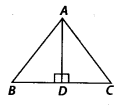
Solution:
False
In ∆ABD and ∆ACD,
AD = AD [common]
∠BAD-∠CAD [∵ AD is the bisector of ∠BAC]
∠ADB = ∠ADC [each 90°, ∵ AD ⊥ BC]
∴ ∆ABD ≅ ∆ACD [By ASA criterion]
Question 107.
The measure of three angles of a triangle are in the ratio 5 : 3 : 1. Find the measures of these angles.
Solution:
Let the angles of the triangle be 5x, 3x and x.
∴ x + 3x + 5x = 180° [Angle sum property of a triangle]
⇒ 9x = 180°
\(\Rightarrow \quad x=\frac{180^{\circ}}{9}=20^{\circ}\)
∴ 3x = 3 × 20° = 60°, 5x = 5 × 20° = 100°
Thus, angles of triangle are 100°, 60° and 20°
Question 108.
In the given figure, find the value of x.
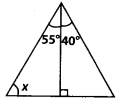
Solution:
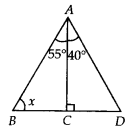
In ∆ABC, ∠ACD = ∠BAC + ∠ABC [Exterior angle property]
⇒ 90° = 55° + x
⇒ x = 90° – 55° = 35°
Thus, x = 35°
Question 109.
In the given figure (i) and (ii), find the values of a, b and c.
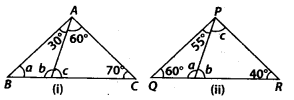
Solution:
(i) In ∆ADC, ∠ADB = ∠DAC+ ∠ACD [Exterior angle property]
b = 60° +70° = 130° …………(i)
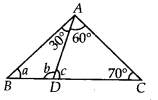
Now, in ∆ABD, ∠ABD + ∠ADB + ∠BAD = 180° [Angle sum property]
⇒ a + b + 30° = 180°
⇒ a = 180° – 30° – 130° (using (1)
⇒ a = 20° ………(ii)
Also, ∠ADC = ∠BAD + ∠ABD [Exterior angle property]
⇒ c = 30° + a
⇒ c = 30° + 20° = 50° [using (ii)]
Thus, a = 20°, b = 130°,c = 50°
(ii) In ∆POS, ∠PSR = ∠SPQ+ ∠PQS [Exterior angle property]
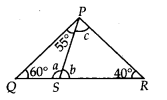
⇒ b = 55° + 60°
⇒ b = 115° …………. (i)
Now, in ∆PRS, ∠PSR + ∠PRS + ∠SPR = 180° [Angle sum property]
⇒ b + 40° + c = 180°
⇒ c = 180° – 40° – 115° [using (i)]
⇒ c = 25° ………. (ii)
Also, ∠PSQ = ∠SPR + ∠SRP [Exterior angle property]
⇒ a = c + 40°
⇒ a = 25° + 40° = 65° [using (ii)]
Thus, a = 65°, b = 115°, c = 25°
Question 110.
In triangle XYZ, the measure of angle X is 30° greater than the measure of angle Yand angle Z is a right angle. Find the measure of ∠Y.
Solution:
Given that
∠X = ∠Y + 40° ……….(i)
∠Z = 90° ……….. (ii)
In ∆XYZ
∠X + ∠Y+∠Z = 180° [Angle sum property]
⇒ ∠Y + 30° + ∠Y + 90° = 180° [Using (i) and (ii)]
⇒ 2 ∠Y = 180°- 90° – 30° = 60°
\(\Rightarrow \quad \angle Y=\frac{60^{\circ}}{2}=30^{\circ}\)
Question 111.
In a triangle ABC, the measure of angle A is 40° less than the measure of angle B and 50% less than that of angle C. Find the measure of ∠A.
Solution:
Given that ∠A = ∠B – 40° …………. (i)
and ∠A = ∠C – 50° …………..(ii)
Now, in ∆ABC
∠A + ∠B + ∠C = 180° [Angle sum property]
⇒ ∠A + ∠A + 40° + ∠A + 50° = 180° [Using (i) and (ii)]
⇒ 3∠A + 90° = 180°
⇒ 3∠A = 180° – 90° = 90°
\(\Rightarrow \quad \angle A=\frac{90^{\circ}}{3}=30^{\circ}\)
Question 112.
I have three sides. One of my angle measures 15°. Another has a measure of 60°. What kind of a polygon am I? If I am a triangle, then what kind of triangle am I?
Solution:
A polygon having three sides is a triangle.
Given that the two angles are of measure 15° and 60°
Let third angle of triangle be x.
∴ 15° + 60° + x = 180° [Angle sum property of a triangle]
⇒ x = 180° – 60° – 15°
⇒ x = 105°
Thus, one angle of triangle is obtuse angle. So, triangle is obtuse-angled triangle.
Question 113.
Jiya walks 6 km due east and then 8 km due north. How far is she from her starting place?
Solution:
Let A be the starting point and B be the ending point of Jiya.

Since ∆ABC is right angled.
∴ (AB)2 = (AC)2 + (BC)2
⇒ (AB)2 = 62 + 82 = 36 + 64 = 100
⇒ AB = 10
Thus, Jiya is 10 km away from her starting place.
Question 114.
Jayanti takes shortest route to her home by walking diagonally across a rectangular park. The park measures 60 metres × 80 metres. How much shorter is the route across the park than the route around its edges?
Solution:
Let ∆BCD be the given rectangular park.

Since, ∆ABC is right angled.
∴ (AC)2 = (AB)2 + (BC)2
⇒ (AC)2 = (80)2 + (60)2 = 6400 + 3600 = 10000
⇒ AC = 100 .
∴ Length of route across the park = 100 m and length of route around the edges = (80 + 60) m = 140 m
Thus, the route across the park is shorter than the route around edges of park by
140 m – 100 m = 40 m.
Question 115.
In ∆PQR of the given figure, PQ = PR. Find the measures of ∠Q and ∠R.
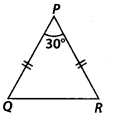
Solution:
∠PRQ ∠PQR [∵ PQ = PR (given)]
Now, in ∆POR
∠PQR + ∠PRQ+ ∠QPR = 180° [Angle sum property]
⇒ 2∠POR + 30° = 180° [using (1)]
⇒ 2∠PQR = 180° – 30° = 150°
\(\Rightarrow \angle P Q R=\frac{150^{\circ}}{2}=75^{\circ}\)
Thus, ∠Q = ∠R = 75°
Question 116.
In the given figure, find the measures of angles x and y.

Solution:
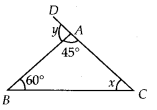
In ∆ABC,
∠BAC + ∠ABC + ∠ACB = 180° [Angle sum property]
⇒ 45° + 60° + x = 180°
⇒ x = 180°- 45° – 60° = 75° ……………. (i)
Now, ∠BAD =∠ABC + ∠ACB [Exterior angle property]
⇒ y = 60° + x
⇒ y = 60° +75° = 135° [using (i)]
Thus, x = 75° and y = 135°
Question 117.
In the given figure, find the measures of ∠PON and ∠NPO.
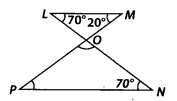
Solution:
In ∆LOM,
∠LOM + ∠OLM+∠OML = 180° [Angle sum property]
⇒ ∠LOM + 70° + 20° = 180°
⇒ ∠LOM = 180° – 70° – 20° = 90°
∠LOM = ∠PON [Vertically opposite angles]
∴ ∠PON = 90°
Now, in ΔΡΟΝ,
∠PON + ∠ONP + ∠NPO = 180° [Angle sum property]
⇒ 90° + 70° + ∠NPO = 180°
⇒ ∠NPO = 180°- 90° – 70° = 20°
Thus, ∠PON = 90° and ∠NPO = 20°
Question 118.
In the given figure QP || RT. Find the values of x and y.

Solution:
QP || RT and PR is a transversal.
∴ ∠QPR = ∠PRT [Alternate interior angles]
⇒ x = 70°
Now, OP || RT and OR is a transversal.
∴ ∠PQR + ∠QRT = 180° [Co-interior angles]
⇒ 30° + y + 70° = 180°
⇒ y = 180° – 30° – 70° = 80°
Thus, a = 70° and y = 80°,
Question 119.
Find the measure of ∠A in the given figure.
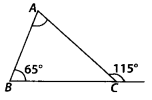
Solution:
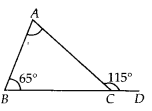
∠ACD = ∠ABC + ∠CAB [Exterior angle property]
⇒ 115° = 65° + ∠CAB
⇒ ∠CAB = 115° – 65°= 50°
Thus, ∠A = 50°
Question 120.
In a right-angled triangle if an angle measures 35°, then find the measure of the third angle.
Solution:
Let ∆ABC be the given triangle such that ∠B = 90° and ∠C = 35°

Now, ∠A +∠B + ∠C = 180° [Angle sum property]
⇒ ∠A = 180°- 90° – 35°
⇒ ∠A = 55°
Thus, third angle of triangle is 55°.
Question 121.
Each of the two equal angles of an isosceles triangle is four times the third angle. Find the angles of the triangle.
Solution:
Let ∆ABC be the given isosceles triangle, such that AB = AC and ∠B = ∠C = x.

Now, ∠B = ∠C = 4∠A ……….. (i) [given]
∠A +∠B +∠C = 180° [Angle sum property]
⇒ ∠A + 4 ∠A + 4 ∠A = 180° [Using (i)]
⇒ 9∠A = 180°
\(\Rightarrow \angle A=\frac{180^{\circ}}{9}=20^{\circ}\)
∴ ∠B = ∠C = 4 × 20° = 80°
Thus, 80, 809 and 20° are the angles of the triangle.
Question 122.
The angles of a triangle are in the ratio 2 : 3 : 5. Find the angles.
Solution:
Let the angles of the triangle be 2x, 3x and 5x.
∴ 2x + 3x + 5x = 180° [Angle sum property of a triangle]
⇒ 10x = 180°
\(\Rightarrow \quad x=\frac{180^{\circ}}{10}=18^{\circ}\)
∴ 2x = 2 × 18° = 36°, 3x = 3 × 18° = 54, 5x = 5 × 18°= 90°
Thus, 36°, 54° and 90°are the angles of the triangle.
Question 123.
If the sides of a triangle are produced in an order, show that the sum of the exterior angles so formed is 360°
Solution:
Let AABC be the given triangle and BD, CE, AF are the produced side in order.
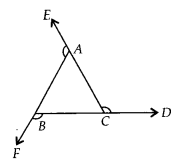
∠ACD = ∠CAB + ∠CBA ………. (i) [Exterior angle property]
∠BAE = ∠ABC + ∠ACB ……… (ii) [Exterior angle property]
∠CBF = ∠BAC + ∠BCA ……….(iii) [Exterior angle property]
Adding (i), (ii) and (iii), we get
∠ACD + ∠BAE +∠CBF = ∠CAB +∠CBA + ∠ABC + ∠ACB + ∠BAC + ∠BCA
⇒∠ACD + ∠BAE + ∠CBF
= 2[∠ABC + ∠ACB + ∠BAC]
= 2(180°) [Angle sum property]
= 360°
Question 124.
In ∆ABC, if ∠A = ∠C, and exterior angle ABX = 140°, then find the angles of the triangle.
Solution:
∠ABX=∠BAC + ∠BCA [Exterior angle property]
⇒ 140° =2∠BAC [∵ ∠A = ∠C]
\(\angle B A C=\frac{140^{\circ}}{2}=70^{\circ}\)

∴ BAC =∠BCA = 70° ……… (i)
Now, in ∆ABC
∠A +∠B + ∠C = 180° [Angle sum property]
⇒ ∠B = 180° – 70° -70 [using (i)]
⇒ ∠B = 40°
Thus, ∠A = 70°, ∠B = 40° and ∠C = 70° are the angles of triangle.
Question 125.
Find the values of x and y in the given figure.
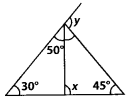
Solution:
In ∆QRS, ∠QST = ∠QRS + ∠SOR [Exterior angle property]
⇒ x = 30° + 50° = 80°
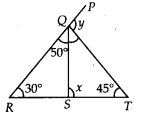
Also, in ∆QRT, ∠PQT = ∠QRT + ∠QTR [Exterior angle property]
⇒ y = 30° + 45° = 75°
Thus, x = 80° and y = 75°
Question 126.
Find the value of x in the given figure.

Solution:
In ∆ABC, ∠ACD= ∠CAB + ∠CBA [Exterior angle property]
⇒ x + 90° = 80° + 30°
⇒ x = 110°- 90° = 20°
Question 127.
The angles of a triangle are arranged in descending order of their magnitudes. If the difference between two consecutive angles is 10, find the three angles.
Solution:
Let ∆ABC be the given triangle and descending order of angles of the triangle is ∠A, ∠B, ∠C
Now, ∠A – ∠B = 10° ………..(i)
∠B – ∠C = 10° ……….. (ii)
Also, ∠A +∠B + ∠C = 180° [Angle sum property]
⇒ ∠B + 10° + ∠B + ∠B – 10° = 180° [Using (i) and (ii)]
⇒ 3∠B = 180°
\(\Rightarrow \angle B=\frac{180^{\circ}}{3}=60^{\circ}\)
∴∠A = ∠B + 10° = 60° + 10° = 70°
and ∠C = ∠B – 10° = 60° – 10° = 50°
Thus, 70°, 60° and 50° are the angles of the triangle.
Question 128.
In ∆ABC, DE || BC (see figure). Find the values of x,y and z.
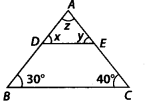
Solution:
DE || BC and AB is a transversal.
∴ ∠ADE = ∠DBC [Corresponding angles]
⇒ x= 30°
Now, DE || BC and AC is a transversal.
∴ ∠AED = ∠ECB [Corresponding angles]
⇒ y = 40°
In ∆ABC,
∠A + ∠B + ∠C = 180° [Angle sum property]
⇒ z + 30° + 40° = 180°
⇒ z = 180° – 40° – 30° = 110°
Thus, x = 30°, y = 40° and z = 110°.
Question 129.
In the given figure, find the values of x, y and z.
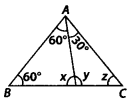
Solution:
In ∆ABD,
∠BAD + ∠BDA + ∠ABD = 180° [Angle sum property]
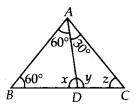
⇒ 60° + x + 60° = 180°
⇒ x = 180° – 120° = 60°
Now, ∠ADC = ∠BAD + ∠ABD [Exterior angle property]
⇒ y = 60° + 60° = 120°
Also, in ∆ADC,
∠ADB – ∠DAC + ∠DCA [Exterior angle property]
⇒ x = 30° + z
⇒ z = 60° – 30° = 30° [∵ x = 60°]
Thus, x = 60°, y = 120° and z = 30°
Question 130.
If one angle of a triangle is 60° and the other two angles are in the ratio 1 : 2, find the angles.
Solution:
Let ∆ABC be the given triangle such that ∠A = 60° and let angle B and C are x and 2x respectively.
∠A + ∠B + ∠C = 180° [Angle sum property]
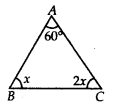
⇒ 60° + x + 2x = 180°
⇒ 3x = 180° – 60° = 120°
\(\Rightarrow \quad x=\frac{120^{\circ}}{3}=40^{\circ}\)
∴ ∠B = 40° and ∠C = 2 × 40° = 80°
Question 131.
In ∆POR, If 3∠P = 4∠Q = 6∠R, calculate the angles of the triangle.
Solution:
In ∆POR,
∠P + ∠Q+ ∠R = 180° [Angle sum property]
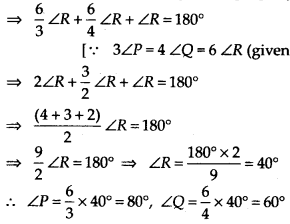
Thus, ∠P = 80°, ∠Q = 60° and ∠R = 40°
Question 132.
In ∆DEF, ∠D = 60°, ∠E = 70° and the bisectors of ∠E and ∠F meet at O. Find
(i) ∠F
(ii) ∠EOF
Solution:
(i) In ∆DEF,
∠D + ∠E +∠F = 180° [Angle sum property]
⇒ 60° +70° + ∠F = 180°
⇒ ∠F = 180° – 60° – 70°= 50°
(ii) Since, EO and FO are the bisectors of ∠E and ∠F respectively.
∴ \(\quad \angle O E F=\angle O E D=\frac{70^{\circ}}{2}=35^{\circ}\)
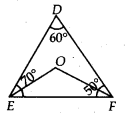
and \(\angle O F E=\angle O F D=\frac{50^{\circ}}{2}=25^{\circ}\)
Now, in ∆OEF, ∠
OEF + ∠OFE+ ∠EOF = 180° [Angle sum property]
⇒ 35° + 25° + ∠EOF = 180°
⇒ ∠EOF = 180° – 35° – 25° = 120°
Question 133.
In the given figure, ∆PQR is right-angled at P.U and Tare the points on line QRF. If OP || ST and US || RP, find ∠S.
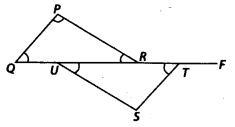
Solution:
QP || ST and QT is a transversal.
∴ ∠PQT = ∠STO [Alternate interior angles]
US || PR and UR is a transversal.
∴ ∠PRU = ∠SUR [Alternate interior angles]
Two angles of ∆PQR equal to two angles of ∆STU. Therefore, third angle also will be equal.
∴ ∠QPR = ∠TSU
Now, given that ∠P = 90°
∴ ∠S = 90°.
Question 134.
In each of the given pairs of triangles of figure, applying only ASA congruence criterion, determine which triangles are congruent. Also, write the congruent triangles in symbolic form.
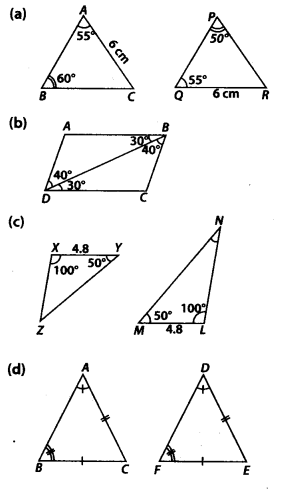
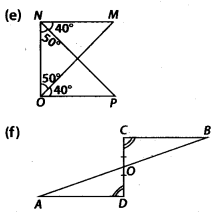
Solution:
(a) In the given figure, ∆ABC and ∆POR are not congruent.
(b) In ∆ABD and ∆CDB,
BD = DB (common)
∠ABD =∠CDB = 30° (given)
∠ADB = ∠CBD = 40° (given)
∴ ∆ABD ≅ ∆CDB (ASA criterion)
(c) In ∆XYZ and ∆LMN,
XY = LM = 4.8 (given)
∠YXZ = ∠MLN – 100° (given)
∠XYZ = LMN = 50° (given)
∴ ∆XYZ ≅ ∆LMN (ASA criterion)
(d) In ∆ABC and ∆DFE,
∠A =∠D (given)
∠B = ∠F (given)
∴∠C = ∠E (since two angles are equal)
BC = FE (given)
∴ ∆ABC ≅ ∆DFE (ASA criterion)
(e) In ∆PON and ∆MNO,
NO = ON (common)
∠NOP = ∠ONM = 50° + 40 = 90° (given)
∠ONP = ∠NOM = 50° (given)
∴ ∆PON ≅ ∆MNO (ASA criterion)
(f) In ∆AOD and ∆BOC,
∠AOD = ∠BOC (Vertically opposite angles)
OD = OC (given)
∠ADO = ∠BCO (given)
∴ ∆AOD ≅ ∆BOC (ASA criterion)
Question 135.
In each of the given pairs of triangles of figure, using only RHS congruence criterion, determine which pairs of triangles are congruent. In case of congruence, write the result in symbolic form:
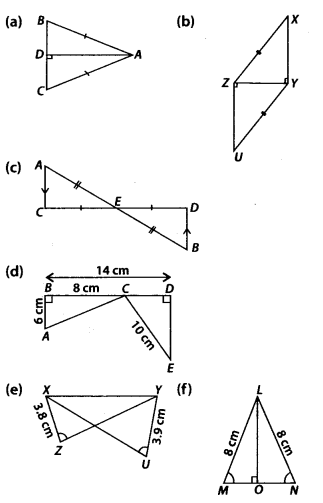
Solution:
(a) In ∆ADB and ∆ADC,
AD = AD (common)
∠ADB = ∠ADC (Each 90°)
AB = AC (given hypotenuse)
∴ ∆ADB ≅ ∆ADC (RHS criterion)
(b) In ∆XYZ and ∆UZY,
∠Y = ∠Z (Each 90°)
XZ = UY (given hypotenuse)
YZ = ZY (common)
∴ ∆XYZ ≅ ∆UZY (RHS criterion)
(c) In ∆ACE and ∆BDE,
∠ACE = ∠BDE (AC || BD, alternate interior angles)
CE = DE (given)
∠AEC = ∠BED (Vertically opposite angles)
∴ ∆ACE ≅ ∆BDE (ASA criterion)
∴ Triangles are congruent but not by RHS congruence criterion
(d) In ∆ABC, by phythagoras theorem
(AC)2 = (AB)2 + (BC)2
= 62 + 82 = 36 + 64 = 100 = 102
∴ AC – 10 cm
In ∆EDC,
DC = BD – BC = (14 – 8) cm = 6cm, CE = 10 cm
Now, in ∆ABC and ∆CDE,
∠B =∠D (each 90°)
AB = CD = 6 cm
AC = CE = 10 cm (hypotenuse)
∴ ∆ABC ≅ ∆CDE (RHS criterion)
(e) In the given figure, ∆XYZ and ∆YXU are not congruent by any criterion.
(f) In ∆LMO and ∆LNO,
LO = LO (common)
LM = LN = 8 cm (hypotenuse)
∠LOM = ∠LON (each 90°)
∴ ∆LOM ≅ ∆LON (RHS criterion)
Question 136.
In the given figure, if RP=RQ, find the value of x.
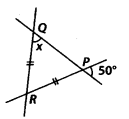
Solution:
RP = RQ
∴ ∠RQP = ∠RPQ = x [angles opposite to equal sides are equal]
Now, ∠RPQ = 50° [vertically opposite angles]
∴ x = 50°
Question 137.
In the given figure, if ST = SU, then find the values of x and y.

Solution:
∠TSU = 78° [vertically opposite angles]
∠SUT = ∠STU = y [∵ ST = SU]
Now, in ∆STU,
∠STU + ∠SUT + ∠TSU = 180° [Angle sum property]
⇒ y + y + 78° = 180°
⇒ 2y = 180° – 78° = 102°
\(\Rightarrow \quad y=\frac{102^{\circ}}{2}=51^{\circ}\)
Now, x = ∠TSU + ∠UTS [Exterior angle property]
⇒ x = 78° + 51°
⇒ x = 129°
Thus, x = 129° and y = 51°,
Question 138.
Check whether the following measures (in cm) can be the sides of a right-angled triangle or not. 1.5, 3.6, 3.9
Solution:
Here, (1.5)2 + (3.6)2 = 2.25 + 12.96 = 15.21 and (3.9)2 = 15.21
Thus, (1.5)2 + (3.6)2 = (3.9)2
Yes, given sides are sides of a right angled triangle.
Question 139.
Height of a pole is 8 m. Find the length of rope tied with its top from a point on the ground at a distance of 6 m from its bottom.
Solution:
Let AB be the given pole of height 8m and rope be AC
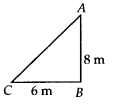
Since, ∆ABC is a right angled triangle.
∴ (AC)2 = (AB)2 + (BC)2
(AC)2 = 82 + 62 = 64 + 36
(AC)2 = 100 = 102
∴ AC = 10 m
Thus, the required length of rope is 10 m.
Question 140.
In the given figure, if y is five times x, find the value of z.

Solution:
In ∆QRS,
∠ROS + ∠RSQ + ∠QRS = 180° [Angle sum property]
⇒ x + y + 60° = 180°
⇒ x + 5x = 180° – 60° [∵ y = 5x (given)]
⇒ 6x = 120°
\(\Rightarrow x=\frac{120^{\circ}}{6}=20^{\circ}\)
∴ y = 5x = 5 × 20° – 100°
Now, ∠RQP = ∠QRS + ∠QSR [Exterior angle property]
z = 60° + 100° = 160°
Question 141.
The lengths of two sides of an isosceles triangle are 9 cm and 20 cm. What is the perimeter of the triangle? Give reason.
Solution:
Sides of isosceles triangle are 9 cm and 20 cm.
Since, sum of any two sides of a triangle is greater than third side.
If third side will be 9 cm then 9 + 9 = 18 < 20
So, the triangle will not form.
∴ Third side of triangle must be 20 cm.
Perimeter = (9 + 20 + 20) cm = 49 cm.
Question 142.
Without drawing the triangles write all six pairs of equal measures in each of the following pairs of congruent triangles.
(a) ∆STU ≅ ∆DEF
(b) ∆ABC ≅ ∆LMN
(c) ∆YZX ≅ ∆POR
(d) ∆XYZ ≅ ∆MLN
Solution:
(a) ∆STU ≅ ∆DEF
ST = DE, TU= LF, SU = DF
∠STU = ∠DEF, ∠SUT = ∠DFE, ∠TSU = ∠EDF
(b) ∆ABC ≅ ∆LMN
AB = LM, BC = MN, AC = LN
∠ABC = ∠LMN, ∠ACB = ANM, ∠BAC =∠MLN
(c) ∆YZX ≅ ∆POR
YZ = PQ, ZX = OR, YX = PR
∠YZX=∠POR, ∠YXZ = ∠PRO, ∠XYZ = ∠RPQ
(d) ∆XYZ ≅ ∆MLN
XY = ML, YZ = LN, XZ = MN
∠XYZ = ∠MLN, ∠XZY = ∠MNL, ∠ZXY = ∠NML.
Question 143.
In the following pairs of triangles of figure, the lengths of the sides are indicated along the sides. By applying SSS congruence criterion, determine which triangles are congruent. If congruent, write the results in symbolic form.
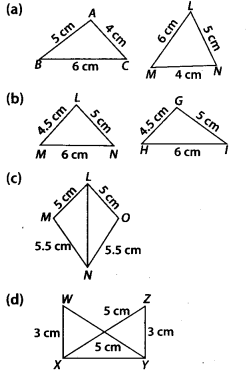
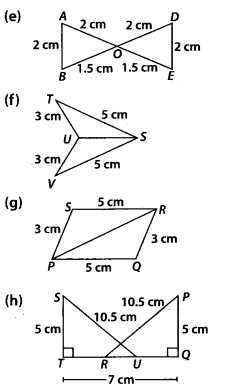
Solution:
(a) In ∆ABC and ∆NLM,
AB = NL = 5 cm (given)
BC = LM = 6 cm (given)
AC = NM = 4 cm (given)
∴ ∆ABC ≅ ∆NLM (SSS criterion)
(b) In ∆LMN and ∆GHI,
LM = GH = 4.5 cm (given)
LN = GI = 5 cm (given)
MN = HI = 6 cm (given)
∴ ∆LMN ≅ ∆GHI (SSS criterion)
(c) In ∆LMN and ∆LON,
LM = LO = 5 cm (given)
MN = ON = 5.5 cm (given)
LN = LN (common)
∴ ∆LMN ≅ ∆LON (SSS criterion)
(d) In ∆XYZ and ∆YXW,
XY = YX (common)
ZY = WX = 3 cm (given)
ZX = WY = 5 cm (given)
∴ ∆YXW ≅ ∆XYZ (SSS criterion)
(e) In ∆AOB and ∆DOE,
AO = DO = 2 cm (given)
AB = DE = 2 cm (given)
BO = EO = 1.5 cm (given)
∴ ∆AOB ≅ ∆DOE (SSS criterion)
(f) In ∆STU and ∆SVU,
SU = SU (common)
ST = SV = 5 cm (given)
UT = UV = 3 cm (given)
∴ ∆STU ≅ ∆SVU (SSS criterion)
(g) In ∆PQR and ∆RSP,
PR = RP (common)
PQ = RS = 5 cm (given)
OR = SP = 3 cm (given)
∴ ∆PQR ≅ ∆RSP (SSS criterion)
(h) In ∆STU, by Pythagoras theorem,
TU2 = (10.5)2 – 52 = 135.25
and in ∆PQR, QR2 = (10.5)2 – 52 = 135.25
∴ TU2 = QR2 ⇒ TU = QR …….. (i)
In ∆STU and ∆POR,
ST = PQ = 5 cm (given)
SU = PR = 10.5 cm (given)
TU = QR (From (1) .
∆STU ≅ ∆PQR (SSS criterion)
Question 144.
ABC is an isosceles triangle with AB = AC and D is the mid-point of base BC (see figure).
(a) State three pairs of equal parts in the triangles ABD and ACD.
(b) Is AABD AACD. If so why?

Solution:
(a) In ∆ABD and ∆ACD,
AD = AD (common)
AB = AC (given)
BD = CD (D is mid-point of BC)
(b) Yes, by using (a) part, we get
∆ABD ≅ ∆ACD (SSS criterion)
Question 145.
In the given figure, it is given that LM = ON and NL = MO
(a) State the three pairs of equal parts in the triangles NOM and MLN.
(b) Is ∆NOM ≅ ∆MLN.

Give reason.
Solution:
(a) In ∆NOM and ∆MLN,
NM = MN (common)
OM = LN (given)
ON = LM (given)
(b) Yes, by using part (a), we get
∆NOM ≅ ∆MLN (SSS criterion)
Question 146.
Triangles DEF and LMN are both isosceles with DE = DF and LM = LN, respectively. If DE = LM and EF = MN, then, are the two triangles congruent? Which condition do you use? If ∠E = 40°, what is the measure of ∠N?
Solution:

In ∆DEF and ∆LMN,
EF = MN (given)
DE = LM given
DF = LN [∵ DE = DF and LM = LN]
∴ ∆DEF ≅ ∆LMN (SSS criterion)
∴ ∠E = ∠M [By C.P.C.T.)
Now, ∠E = 40° ⇒ ∠M = 40°
Since, ∠M = ∠N [∵ LN = LM]
∴ ∠N = 40°
Question 147.
If APQR and ASOR are both isosceles triangle on a common base OR such that P and S lie on the same side of QR. Are triangles PSQ and PSR congruent? Which condition do you use?
Solution:
Let ∆PQR and ∆SOR are the given triangles such that PQ = PR and SQ = SR.
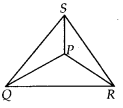
Now, in ∆PSQ and ∆PSR,
PQ = PR (given)
SQ = SR (given)
PS = PS (common)
∴ ∆PSQ ≅ ∆PSR (SSS criterion)
Yes, the ∆PSQ and ∆PSR are congruent by using SSS criterion
Question 148.
In the given figure, which pairs of triangles are congruent by SAS congruence criterion (condition)? if congruent, write the congruence of the two triangles in symbolic form.
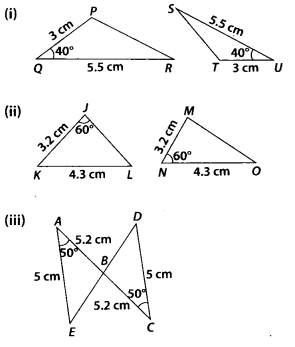
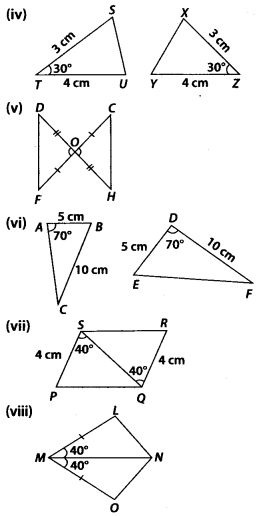
Solution:
(i) In ∆POR and ∆TUS,
PQ = TU = 3 cm (given)
OR = US = 5.5 cm (given)
∠POR = ∠TUS = 40° (given)
∴ ∆POR ≅ ∆TUS (SAS criterion)
(ii) In the given figure, ∆JKL and ∆MNO are not congruent by any criterion.
(iii) In ∆ABE and ∆CBD,
∠EAB = ∠DCB = 50° (given)
AE = CD = 5 cm (given)
AB = CB = 5.2 cm (given)
∴∆ABE ≅ ∆CBD (SAS criterion)
(iv) In ∆SUT and ∆XYZ
ST = XZ = 3 cm (given)
UT = YZ = 4 cm (given)
∠STU = ∠XZY = 30° (given)
∴ ∆SUT ≅ ∆XYZ (SAS criterion)
(v) In ∆DOF and ∆HOC,
DO = HO (given)
FO = CO (given)
∠DOF = ∠HOC (Vertically opposite angles)
∴ADOF ≅ AHOC (SAS criterion)
(vi) In the given figure, ∆ABC and ∆DEF are not congruent by any criterion.
(vii) In ∆PSQ and ∆RQS.
SQ = QS (common)
PS = RQ = 4 cm (given)
∠PSQ = ∠RQS = 40° (given)
∴ ∆PSQ ≅ ∆ROS (SAS criterion)
(viii) In ∆LMN and ∆OMN,
MN = MN (common)
LM = OM (given)
∠LMN = ∠OMN = 40° (given)
∴ ∆LMN ≅ ∆OMN (SAS criterion)
Question 149.
State which of the following pairs of triangles are congruent. If yes, write them in symbolic form (you may draw a rough figure).
(a) ∆POR : PQ = 3.5 cm, OR = 4.0 cm, ∠Q=60°
∆STU : ST = 3.5 cm, TU= 4 cm, ∠T = 60°
(b) ∆ABC : AB = 4.8 cm, ∠A = 90°, AC = 6.8 cm
∆XYZ : YZ = 6.8 cm, ∠X = 90°, ZX = 4.8 cm
Solution:
(a)

In ∆PQR and ∆STU,
PQ = ST = 3.5 cm (given)
∠PQR = ∠STU = 60° (given)
OR = TU = 4 cm (given)
∴ ∆PQR ≅ ∆STU (SAS criterion)
(b) Here, ∆ABC and ∆XYZ are not congruent by any criterion.
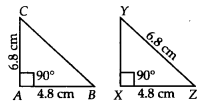
Question 150.
In the given figure, PO = PS and ∠1 = ∠2.
(i) Is ∆POR = ∆PSR? Give reasons.
(ii) Is QR = SR? Give reasons.
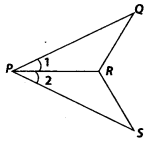
Solution:
(i) In ∆PQR and ∆PSR,
PQ = PS (given)
∠1 = ∠2 (given)
PR = PR (common)
∴ ∆POR ≅ ∆PSR (SAS criterion)
(ii) Yes, QR = SR (By C.P.C.T.)
Question 151.
In the given figure, DE = IH, EG = FI and ∠E = 21. Is ∆DEF ≅ ∆HIG? If yes, by which congruence criterion?
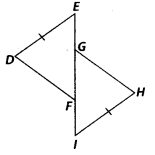
Solution:
In ∆DEF and ∆HIG,
DE = HI (given)
∠E = ∠I (given)
EF = IG

∴ ∆DEF ≅ ∆HIG (SAS criterion)
Question 152.
In the given figure, ∠1 = ∠2 and ∠3 = ∠4.
(i) Is ∆ADC ≅ ∆ABC? Why?
(ii) Show that AD = AB and CD = CB.
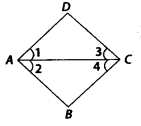
Solution:
(i) In ∆ADC and ∆ABC,
∠1 = ∠2 (given)
AC = AC (common)
∠3 = ∠4 (given)
∴ ∆ADC = ∆ABC (ASA criterion)
(ii) By using (i) part, we get
AD = AB (By C.P.C.T.)
and CD = CB (By C.P.C.T.)
Question 153.
Observe the given figure and state the three pairs of equal parts in triangles ABC and DBC.
(i) Is ∆ABC = ∆DCB? Why?
(ii) Is AB = DC? Why?
(iii) Is AC = DB? Why?

Solution:
(i) In ∆ABC and ∆DCB,
∠ABC = ∠DCB = 40° + 30 = 70° (given)
∠ACB = ∠DBC = 30° (given)
BC = CB (common)
∴ ∆ABC ≅ ∆DCB (ASA criterion)
(ii) Yes, by using (1) part, we get
AB = DC (By C.P.C.T.)
(iii) Yes, by using (1) part, we get
AC = DB (By C.P.C.T.)
Question 154.
In the given figure, OS ⊥ PR, RT ⊥ PQ and QS = RT.
(i) Is ∆QSR = ∆RTO? Give reasons.
(ii) Is ∠PQR = ∠PRQ? Give reasons.
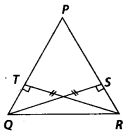
Solution:
(i) In ∆QSR and ∆RTO,
∠OSR = ∠RTO = 90° (∵ QS ⊥ PR and RT ⊥ PQ (given))
QS = RT (given)
QR = RO (common hypotenuse)
∴ ∆QSR ≅ ∆RTQ (RHS criterion)
(ii) Yes, by using (1) part, we get
∠TQR = ∠SRQ (By C.P.C.T)
⇒ ∠PQR = PRQ
Question 155.
Points A and B are on the opposite edges of a pond as shown in figure. To find the distance between the two points, the surveyor makes a right-angled triangle as shown. Find the distance AB.
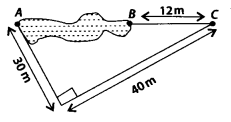
Solution:
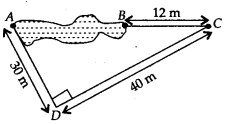
Since, ∆ADC is right-angled triangle
∴ (AC)2 = (AD)2 + (CD)2
= (30)2 + (40)2 = 900 + 1600 = 2500 = (50)2
∴ AC = 50 m
Now, AB = AC – BC = 50 – 12 = 38
Thus, the distance AB is 38 m.
Question 156.
Two poles of 10 m and 15 m stand upright on a plane ground. If the distance between the tops is 13 m, find the distance between their feet.
Solution:
Let AB and CD are the given poles of heights 15 m and 10 m such that AC = 13 m.
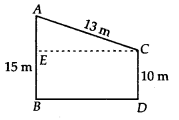
Now, BD = CE and BE = CD = 10 m
∴ AE = AB – BE = (15 – 10) m = 5 m
Now, in ΔAEC,
(AC)2 = (AE)2 + (EC)2
⇒ (13)2 = 52 + (EC) 2
⇒ (EC)2 = 169 – 25 = 144 – (12)2
∴ EC = 12 m
Also, BD – 12 m
Thus, distance between the feet of poles is 12 m.
Question 157.
The foot of a ladder is 6 m away from its wall and its top reaches a window 8 m above the ground,
(a) Find the length of the ladder.
(b) If the ladder is shifted in such a way that its foot is 8 m away from the wall, to what height does its top reach?
Solution:
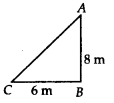
(a) Let AC be the given ladder such that BC = 6 m and AB = 8 m
Now, in ΔABC,
(AC)2 = (AB)2 + (BC)2
= 82 + 62
= 64 + 36 = 100 = (10)2
∴ AC = 10 m
Thus, length of the ladder is 10 m.
(b) Let AC be the ladder of length 10 m and BC = 8 m.

In ΔABC,
(AC)2 = (AB)2 + (BC)2
⇒ (10)2 = (AB)2 + (8)2
⇒ (AB)2 = 100 – 64 = 36 = (6)2
∴ AB = 6 m
Thus, the ladder top reaches 6 m above the ground.
Question 158.
In the given figure, state the three pairs of equal parts in ΔABC and ΔEOD. Is ΔABC = ΔEOD? Why?
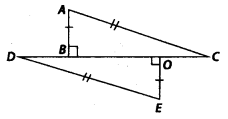
Solution:
In ΔABC and ΔEOD,
AB = EO (given)
∠ABC = ∠EOD = 90° (given)
AC = ED (given hypotenuse)
∴ AABC ≅ AEOD (RHS criterion)
We hope the NCERT Exemplar Class 7 Maths Chapter 6 Triangles will help you. If you have any query regarding NCERT Exemplar Class 7 Maths Solutions Chapter 6 Triangles, drop a comment below and we will get back to you at the earliest.